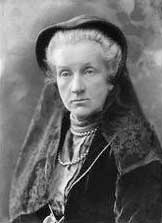Lady Frances Balfour 1858-1931
 Unusual in that she came from the upper classes, which, on the whole, were very anti-suffrage. She was the 10th child of the Duke & Duchess of Argyll. They were a Liberal family, both her mother and grandmother were in the anti-slavery movement. However her husband’s family were Conservative. He was brother to the Prime Minister Arthur Balfour. This did not prevent her following her own instincts and beliefs.
Unusual in that she came from the upper classes, which, on the whole, were very anti-suffrage. She was the 10th child of the Duke & Duchess of Argyll. They were a Liberal family, both her mother and grandmother were in the anti-slavery movement. However her husband’s family were Conservative. He was brother to the Prime Minister Arthur Balfour. This did not prevent her following her own instincts and beliefs.
She argues that she became part of the suffrage movement by inclination not by conversion. Her role in the suffrage campaign was varied but chiefly limited to influence and propaganda. She was not an organiser. Her contribution lay in her role as ‘liaison’ officer between the suffrage movement and the Commons and as a public speaker. She made speeches on the franchise from platforms the length and breadth of the country. During one autumn she recorded she had spoken at 60 meetings She was a constitutional suffragist rather than a militant suffragette.
She disapproved of law breaking to show that women were fit for law making and also felt that the strategy of co-operation with any politician willing to endorse an extension of the franchise, as advocated by the WSPU, would mean supporting the ‘Socialists’ (later the Labour party). If one adds to this her political concerns over suffragettes attacks on Liberals and issues of respectability there existed a chasm between lady Frances Balfour and the WSPU, but she recognised that the militants by their actions generated tremendous publicity for the cause and stimulated debate and interest.
But there never existed such an obvious dividing line within the suffrage movement. The militants may have been condemned for their aggressive tactics but there was a genuine admiration expressed, even among the most law-abiding members, for their bravery and courage.
Come the war and Frances took the pro-war side. The subsequent enfranchisement of women over 30 in 1918 was considered by her to be a job only half done and she continued the struggle. Part of this was to write a biography of Elsie Inglis. After the vote was won she continued working for women’s rights through the National Council of Women of Great Britain and Ireland becoming its president in 1921 until her death.
She also campaigned for women to have a greater role within the church. She was in favour of women becoming Elders and wanted to see them allowed into the ministry. Her views on equality for women in the workplace were contradicted by her preference for a free market, so she opposed legislation that would ‘cost the employer money’ i.e. would benefit the worker. She was one of only two women appointed to the Royal Commission On Divorce and Matrimonial Causes (1910-1912).
References:
William W J Knox: Lives of Scottish Women, Women and Scottish Society 1800-1980.
Picture: National Portrait gallery London
